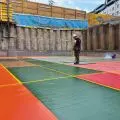The article is from A&B issue 10|23
Let's start with what underground water is. In a nutshell, it is the water found beneath the Earth's surface in the pores of rocks and soils and in the fractures of rock formations. Contrary to popular belief, it does not form underground rivers and lakes, but accumulates in so-called aquifers, which can be compared to underground water storage sponges. Water seeps into these shallowest layers from the earth's surface.
Underground water is one of the most underestimated and at the same time one of the most valuable sources of fresh water suitable for economic use. Its global reserves are about 23.4 million km3. One could say after Fox from "The Little Prince" that "the most important thing is invisible to the eyes," and in this quote one finds the whole truth about underground water. You can't see it, yet it plays a key role both in the supply of drinking water to the population, in the functioning of all ecosystems, and in water management. In Poland, almost 70 percent of drinking water is supplied precisely from groundwater intakes, of which as much as 66 percent is from the shallowest, Quaternary aquifers.
Water is a scarce resource of the 21st century, the lack of which is particularly felt in large cities, industrial areas and areas of intensive farming and animal husbandry. We increasingly face extreme weather events - violent and torrential storms or prolonged heat waves. In conjunction with tight urban development, through which water from the surface cannot soak into aquifers, this leads to an increase in surface runoff and rapid drainage of rainwater out of cities, and, in hot weather, to evaporation of residual stored water from the ground. In times of global drought, city authorities face a number of consequences due to limited water retention capacity. This is due in part to a lack of accurate and detailed knowledge of the underground environment and the interaction between groundwater and urban infrastructure and the comfort of residents. In the process of sustainable development of urban areas, special importance should be given to multidimensional urban planning, in which groundwater should play an important role. This is because well-recognized hydrogeological conditions in a city make it possible to appropriately design the maintenance of vegetation in parks and urban green spaces during periods of drought, cooling and storage of heat in the near-surface layers of the earth, foundation conditions for structures and infrastructure and engineering facilities, as well as the collection of excess water appearing on the surface. Underground water is also responsible for the recharge of rivers during rainless periods - without this recharge, rivers would dry up completely. Underground retention and protection of the quality and quantity of groundwater resources should therefore be among the priorities in urban development. Where geological conditions allow, natural underground water reservoirs, in addition to their water management functions, can also serve as energy storage facilities and provide a kind of ecological and emission-free source of heat and cooling. Where the quality of underground water is monitored and protected, it is a valuable source of drinking water, more stable and resistant to pollution than surface water. Sensible unclogging of cities and designing water retention solutions based on nature is one of the main paths to sustainable development of Polish cities.
















